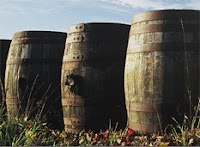 Many types of wood have been used to make whisky casks during the history of the industry. Now, by law they now must be constructed of oak. Oak is selected for its toughness yet is easy for the cooper (the people who make casks) to work with, has tight grain that prevents leaking, is porous that allows oxygen in and out of the cask and it can be bent by heat without splitting.
Many types of wood have been used to make whisky casks during the history of the industry. Now, by law they now must be constructed of oak. Oak is selected for its toughness yet is easy for the cooper (the people who make casks) to work with, has tight grain that prevents leaking, is porous that allows oxygen in and out of the cask and it can be bent by heat without splitting.Wood (and especially oak) is full of naturally occurring oils called vanillins. These oils are drawn out of the cask by the spirit during maturation and they add to the whisky’s flavour profile. So if all whisky is matured in oak casks, how can they all be different when tasted? The character of the distillery, the ingredients used, the size and shape of the stills and its location are all important but the major factor is the type of oak cask used for maturation. Between 60-80% of a whisky's flavour can come from the cask. There are three main types of wood used by the whisky industry.
European oak (Latin name Quercus robur)
This type of oak has traditionally been used to mature whisky in Scotland and Ireland for nearly two centuries. Until the 1860s, oak from England and Scotland had been used to mature whisky but these casks were particularly prone to leaking. Russian oak was then imported that was stronger and less porous but this was expensive. When the Spanish started sending their sherry over to the UK in the 1860s, the casks used for maturation and transportation were made from Spanish oak. They had similar properties to Russian oak but were much cheaper. This oak is traditionally grown in the Galicia region of northern Spain and although the sherry industry has declined since the 1970s, Spanish oak is still commonly used and sought after. This is despite the price of a sherry cask currently costing nearly 10 times as much as a bourbon American oak cask.
The other type of European oak commonly used in modern whisky maturation is French oak. This is traditionally made into casks for the wine industry and these are mostly used by distilleries to give a different ‘finish’ to their whiskies.
Flavour key words - sherry, dried fruits - sultanas, raisins, candied peel, spices - cinnamon, nutmeg, wood, caramel, orange, Christmas cake.
American oak (Quercus alba)
This has been used in the whisky industry since the end of the Second World War. At that time, the Cooper's Union and lawyers formulated the law that stipulated that all American whiskey had to be matured in new wooden casks. This was done to boost the coopering industry that had collapsed during Prohibition in the 1920s and 30s. As a result, there was a massive increase in the number of casks available. The American bourbon whiskey industry slowly recovered from Prohibition and the Scots and Irish began using their casks for maturation. This was due to the good availability and price of bourbon casks compared to the more traditional sherry casks, whose numbers were declining and becoming more expensive.
American oak is seen as perfect for whisky cask construction as the trees are fast growing with tall straight trunks, giving good quality wood and high levels of vanillins. The size of cask produced (known as an ASB - American Standard Barrel) is also considered to mature whiskey at the optimum rate as there is the perfect ratio between the amount of liquid and the surface area of the inside of the cask. The result of this is that nearly 90% of all the world's whisky is now matured in American oak bourbon casks.
Flavour key words - vanilla, honey, nuts - coconut, almonds, hazelnuts, butterscotch, fudge, spices - ginger.
Japanese oak (Quercus mongolica)
Also known as mizunara oak, this type of wood is used in the Japanese whisky industry. Mizunara has been used since the 1930s and gives the whisky a unique set of flavours. The wood has extremely high levels of vanillins but is soft and very porous, making the casks made from mizunara oak very prone to leaking and easily damaged. As a result, the practice of maturing whisky was modified in order to reduce these factors. Now most Japanese whisky is matured in either bourbon or sherry casks and then transferred to mizunara casks to gain its flavoursome characteristics.
Flavour key words - vanilla, honey, floral - blossom, fresh fruit - pears, apples, spice - nutmeg, cloves, wood.

2 comments:
Just to ask, you say that around 90% of global whisky is matured in American oak bourbon casks. But this just refers to the size, shape and wood used right, not that all non-bourbon whiskies use casks that contained bourbon previously? I'm assuming that companies/distilleries outside of the USA import the wood and then construct the casks themselves, any idea? (Thanks for the postings, I enjoy the site.)
That's correct, USA exports used bourbon casks. E.g. In Scotland nobody can use new wood.
Post a Comment